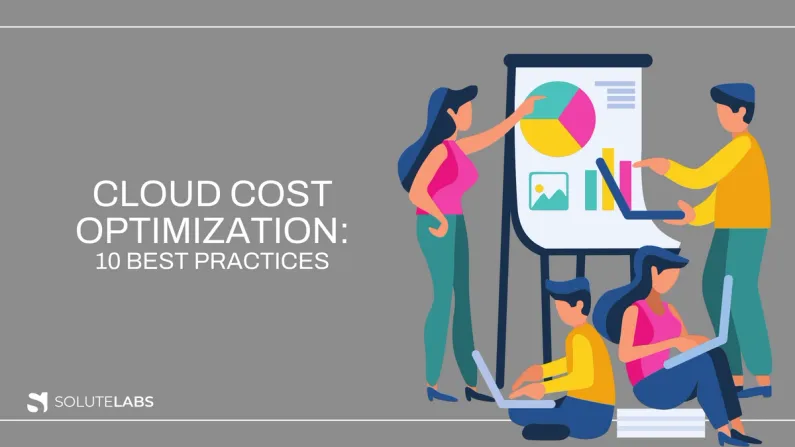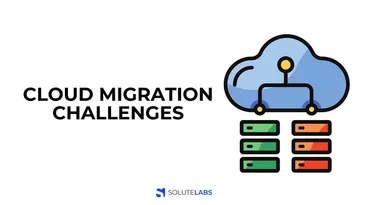Cloud computing has revolutionized the way businesses operate, enabling them to access computing resources and applications on-demand. This has led to an increase in the adoption of cloud services by businesses of all sizes. However, this has also led to an increase in cloud costs. In order to manage cloud costs and ensure that businesses are getting the most value for their money, cloud cost optimization has become a critical aspect of cloud management. In this blog, we'll explore what cloud cost optimization is, its importance, and 10 best practices to optimize cloud costs.
What is Cloud Cost Optimization?
Cloud cost optimization refers to the process of optimizing cloud expenses to ensure that businesses are getting the most value for their money. It involves identifying areas where costs can be reduced without compromising the quality of service, and implementing measures to reduce costs. Cloud cost optimization is a continuous process and requires ongoing monitoring and analysis to identify opportunities for optimization.
Importance of Cloud Cost Optimization
1. Cost Savings:
Cloud computing services can be a significant expense for businesses, especially those that rely heavily on cloud services for their day-to-day operations. Optimization helps businesses to identify areas where they can save money by reducing unnecessary spending. By monitoring and analyzing their cloud costs, businesses can identify services or resources that are underutilized or overprovisioned, and make necessary adjustments.
2. Efficient Resource Utilization
By optimizing cloud costs, businesses can ensure that their cloud resources are being used effectively and efficiently. This leads to improved performance, and better customer experiences and satisfaction. Optimization also helps businesses to be more agile and responsive to changing business needs. Adjusting the cloud usage to meet changing demands, ensures that there are resources available for new opportunities, thereby having opportunities to expand and remain competitive in their industry.
3. Improved Service Quality
Cost optimization enables businesses to identify areas where they can save money on their cloud services without compromising service quality. Thereby businesses can ensure that they are getting the best value for their money, and investing in the resources they need to provide the best services to their customers.
Also, it helps businesses identify areas where they may be overspending on cloud services. By identifying and eliminating unnecessary expenses, businesses can allocate their resources more effectively and invest in areas that are critical to their business success. This can improve service quality by enabling businesses to prioritize investments that directly impact their customers.
4. Competitive Advantage
In today’s business landscape, lower costs are a key competitive advantage over competitors. Cloud cost optimization enables businesses to offer services at a lower cost than their competitors.
- By reducing cloud costs, businesses can pass on those savings to their customers, offering lower prices, better deals, or more value-added services. As a result, attracting new customers, retaining existing ones, and increasing market share.
- Lower costs also improve the profitability and financial stability of the business. This can enable them to invest in other areas of their business that can help them grow and expand.
- By optimizing cloud costs, businesses can also become more agile and responsive to changes in the market. Quickly adjusting the cloud usage to meet changing demands, enables them to take advantage of new opportunities or respond to threats in a timely manner.
5. Scalability
As discussed in the above points, cloud cost optimization enables businesses to allocate their cloud resources more efficiently, which helps in scaling operations more effectively.
- Businesses can identify and eliminate unnecessary expenses, freeing up resources that can be used for other initiatives. This can include investing in new products or services, hiring new employees, or expanding into new markets.
- Cloud cost optimization also enables businesses to increase or decrease their cloud usage as required, enabling them to respond quickly to changes in demand.
- Optimization also helps avoid overprovisioning or underutilization of resources, thereby leading to better performance and ensuring delivery of the best possible services to their customers.
6. Improved Decision Making
By monitoring and analyzing cloud costs,
- Businesses can identify areas where they may be overspending or underutilizing resources, and make necessary adjustments. This can enable businesses to make more informed decisions about their cloud usage, investment, and strategy.
- With better insight into the cost of different cloud services and applications businesses can make more informed decisions about which services and applications to use, and which ones to avoid.
- It also helps businesses in aligning their cloud usage with their business goals. By optimizing cloud costs, businesses can allocate their resources more effectively, and invest in the areas that are critical to their business success. This can help businesses achieve better performance, and improve their overall business outcomes.
Also, Read: AWS vs Azure vs Google Cloud - Choose for your Enterprise
Best Practices for Cloud Cost Optimization
Best Practice #1: Monitor Cloud Costs
The first step in cloud cost optimization is to monitor cloud costs. This involves tracking cloud usage and identifying areas where costs can be reduced. There are several tools available for monitoring cloud costs, including cloud provider tools, third-party tools, and custom-built tools.
The metrics to track include:
- Monthly spending by service
- Monthly spending by resource
- Monthly spending by application
- Monthly spending by department
- Monthly spending by project
By monitoring cloud costs, businesses can identify areas where costs can be reduced and take action to optimize costs.
Best Practice #2: Analyze Cloud Usage
In addition to monitoring cloud costs, it's important to analyze cloud usage. This involves tracking how cloud resources are being used and identifying areas where resources are being underutilized. There are several tools available for analyzing cloud usage, including cloud provider tools, third-party tools, and custom-built tools.
The metrics to track include:
- CPU usage
- Memory usage
- Network usage
- Disk usage
By analyzing cloud usage, businesses can identify areas where resources can be optimized and take action to reduce costs.
Best Practice #3: Rightsize Resources
Rightsizing resources involves ensuring that resources are appropriately sized for the workload they are supporting. This involves identifying overprovisioned resources and downsizing them to reduce costs. There are several tools available for rightsizing resources, including cloud provider tools, third-party tools, and custom-built tools.
The benefits of rightsizing resources include:
- Cost savings
- Improved performance
- Better resource utilization
By rightsizing resources, businesses can optimize costs and improve resource utilization.
Best Practice #4: Use Reserved Instances
Reserved instances are a type of pricing model offered by cloud providers that enable businesses to reserve capacity for a specified period of time in exchange for a discounted hourly rate. By using reserved instances, businesses can save money on cloud services.
The benefits of using reserved instances include:
- Cost savings
- Predictable costs
- Increased stability
There are several tools available for using reserved instances, including cloud provider tools, third-party tools, and custom-built tools. By using reserved instances, businesses can optimize costs and improve cost predictability.
Best Practice #5: Utilize Spot Instances
Spot instances are a type of pricing model offered by cloud providers that enable businesses to bid on unused capacity in exchange for a lower hourly rate. By utilizing spot instances, businesses can save money on cloud services.
The benefits of using spot instances include:
- Cost savings
- Increased flexibility
- Improved scalability
There are several tools available for using spot instances, including cloud provider tools, third-party tools, and custom-built tools. By utilizing spot instances, businesses can optimize costs and improve cost flexibility.
Best Practice #6: Optimize Storage
Storage optimization involves ensuring that data is stored efficiently to reduce costs. This involves identifying unused data and deleting it, compressing data, and using tiered storage to store data based on its usage. There are several tools available for storage optimization, including cloud provider tools, third-party tools, and custom-built tools.
The benefits of storage optimization include:
- Cost savings
- Improved performance
- Better resource utilization
By optimizing storage, businesses can reduce costs and improve resource utilization.
Best Practice #7: Use Cloud Cost Management Tools
Cloud cost management tools are software applications that enable businesses to manage and optimize their cloud costs. These tools provide visibility into cloud spending, automate cost optimization, and provide cost analysis and reporting.
The benefits of using cloud cost management tools include:
- Improved visibility
- Cost optimization automation
- Cost analysis and reporting
There are several popular cloud cost management tools available, including CloudHealth, CloudCheckr, and Cloudability.
Best Practice #8: Implement Automated Cost Optimization
Automated cost optimization involves using software applications to automate the process of cost optimization. This involves setting up rules and policies to automatically adjust cloud resources based on usage and demand.
The benefits of automated cost optimization include:
- Cost savings
- Improved resource utilization
- Better performance
There are several tools available for automated cost optimization, including cloud provider tools, third-party tools, and custom-built tools.
Best Practice #9: Adopt a Cloud Cost Optimization Strategy
Adopting a cloud cost optimization strategy involves creating a plan for managing and optimizing cloud costs. This involves setting goals, identifying areas for optimization, and implementing measures to achieve cost savings.
The steps to create a cloud cost optimization strategy include:
- Set goals
- Analyze cloud costs and usage
- Identify areas for optimization
- Implement optimization measures
- Monitor and adjust the strategy
By adopting a cloud cost optimization strategy, businesses can ensure that they are optimizing costs effectively.
Best Practice #10: Continuously Monitor and Optimize Cloud Costs
Cloud cost optimization is a continuous process and requires ongoing monitoring and optimization. This involves regularly reviewing cloud costs and usage, identifying areas for optimization, and implementing measures to reduce costs. By continuously monitoring and optimizing cloud costs, businesses can ensure that they are getting the most value for their money.
Also, Read: How Can Enterprises Protect Their Data In A Cloud Environment?
Conclusion
Cloud cost optimization is a critical aspect of cloud management that enables businesses to optimize costs, improve resource utilization, and achieve better performance. By following the 10 best practices outlined in this blog, businesses can optimize their cloud costs effectively. By monitoring cloud costs, analyzing cloud usage, rightsizing resources, using reserved and spot instances, optimizing storage, using cloud cost management tools, implementing automated cost optimization, adopting a cloud cost optimization strategy, and continuously monitoring and optimizing cloud costs, businesses can ensure that they are getting the most value for their money.
Need help optimizing your cloud costs? Contact SoluteLabs today to learn more about our cloud engineering solutions and how we can help you save money and improve performance. Get in touch now!
Frequently Asked Questions
Have a product idea?
Talk to our experts to see how you can turn it
into an engaging, sustainable digital product.




